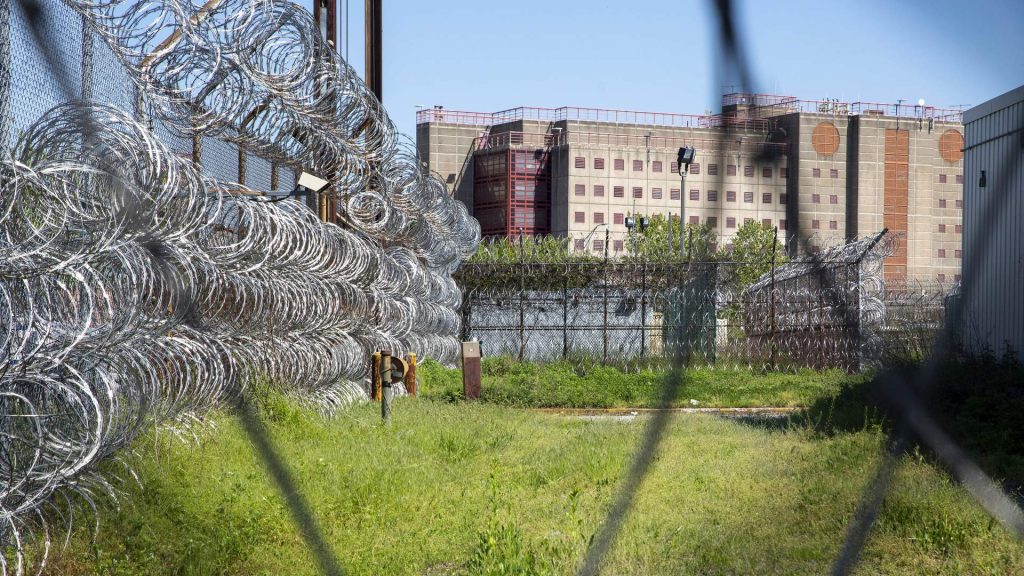New York City mayor’s race may determine future of notorious Rikers Island

NEW YORK — In the shadow of a massive jail, a leafy Chinatown park welcomed New Yorkers playing mahjong, basketball and saxophone. But last year, the shadow vanished.
New York City demolished its downtown detention center, known as The Tombs, leaving behind a gaping chasm. In its place could be the world’s tallest jail, as tall as the Statue of Liberty. It is slated for completion in 2032.
This is one of four new jails to be built as part of New York’s Borough-Based Jails program, the country’s most high-profile effort to replace derelict detention facilities. Initiated in 2017, it’s also the keystone of the largest criminal justice reform effort in the city’s history. Perhaps most significant, the program mandates the closure of Rikers Island — a remote, toxic landfill with eight active jails — by 2027.
After a 14-year legal battle, a federal judge ruled that the city is not fit to rule these jails due to chronic mismanagement and violence. The judge mandated a federal takeover.
For now, Rikers continues to be the scene of death, abuse and isolation. This year alone, 12 people died there.
But in Rikers’ place, the city is planning to build four new jails in the boroughs, closer to courthouses, at a cost of $15.5 billion.
Despite these plans, Rikers’ future has become an issue in this year’s campaign to choose New York City’s new mayor. Independent candidate Andrew Cuomo, the former New York governor who resigned after a sexual misconduct scandal in 2021, said he wants to ditch the Borough-Based Jails program and keep Rikers alive in the East River.
“My plan is to rebuild Rikers,” Cuomo said Wednesday at the New York Chinese Community Center in Chinatown. “The island is fine. The island did nothing wrong.”
Last week, Cuomo compared the jail program to Boston’s Big Dig, the country’s most expensive highway project. It took 15 years to build and cost five times more than projected.
“We should rebuild new state-of-the-art jails on Rikers Island and use those existing sites for housing and commercial development,” Cuomo said at the Chinatown event.
Cuomo’s position has sparked both controversy and support.
New York’s mayoral frontrunner, Democrat Zohran Mamdani, who maintains a 13-point lead on Cuomo in recent polling, strongly criticized the former governor’s plan.
“To take that which is broken, that which is morally bankrupt, that which is a stain on our city, and to keep it open — it’s a betrayal not only of the law as it stands today, but of what New Yorkers actually want,” Mamdani said.
New York City, a bellwether
With a growing trend in redesigning correctional facilities, such as Chicago’s Cook County jail, California’s San Quentin prison in California and the Bexar County jail in Texas, New York’s Borough-Based Jails program could become a model for the nation — if the next mayor doesn’t scrap it.
Some advocates of criminal justice reform, however, oppose the program.
“How New York City solves its incarceration crisis matters far beyond our five boroughs,” Chinatown advocate and architect William Bialosky, told Straight Arrow News. “We run the largest jail system in the country, and other cities — Los Angeles, Chicago, Philadelphia — watch what we do and follow our lead. If we build these borough-based jail towers … we’re telling every city in America that this is the answer: More warehousing, more institutional towers with no room for real programming, the same approach that hasn’t worked for 50 years.”
Many jails around the nation are crumbling, with outdated facilities and inhumane conditions. New York portrays its planned new jails as more humanely designed, nestled into neighborhoods and closer to the friends, families and lawyers of incarcerated persons. The new plan also calls for fewer beds, by design forcing a reduction in the city’s incarcerated population.
This year’s mayoral race, which will fill an open seat now that Mayor Eric Adams has dropped his reelection campaign, may indicate how New Yorkers view civil rights, police reform and public safety issues. It also reflects a larger zeitgeist of how Americans are choosing to deal with issues of race and equality, as well as the legal system.
Rikers is crumbling
For much of its almost 100-year history, Rikers has faced demands to close. Since Adams took office in 2022, at least 42 people have died there.
Most of Rikers’ 7,000 inhabitants are jailed while awaiting trial because they cannot afford bail. Others are serving short-term sentences.
Keeping them locked up is extremely expensive: $556,539 per incarcerated person per year.
But the Borough-Based Jails program has also sparked controversy since its inception eight years ago. Its opponents include architect Bialosky and Wai Wah Chin, the founding president of the Chinese Americans Citizens Alliance of Greater New York. Both back Cuomo’s plan.
“You can’t restore people in skyscrapers,” said Bialosky, who represents local architects opposed to a new jail in Manhattan.
Bialosky and his team created an alternative, which calls for razing Rikers, rebuilding it as a rehabilitation campus for incarcerated people and connecting it to other boroughs through a ferry system.
“We need daylight, access to nature in low-rise buildings and connection to the earth and air for us to have any hope of restoring ourselves and our souls,” Bialosky told SAN. ”The BBJ plan is a dinosaur. They’re just repeating the mistakes of the past, just stacked on top of each other.”
Many locals who oppose the plan demand affordable housing, rather than a new jail in their neighborhoods.
Chin, a fellow at conservative think tank the Manhattan Institute, said a new downtown Manhattan jail would be harmful to the community.
“I don’t know anybody in Chinatown who wants it,” Chin told SAN. “It’s going to be extremely, extremely harmful for the community. … We have plenty of jails.”
She said Rikers Island can accommodate a major renovation or replacement.
“Do the remediation,” Chin said.
Locals protest new jail
On Wednesday, Chin and Bialosky also spoke at the New York Chinese Community Center press conference and community event where Cuomo appeared. Every seat was filled with community members, leaders and media. Many people supported Cuomo’s alternative to keep the jail on Rikers.
The site for each new planned new jail “could become a housing development with nearly 1,000 bedrooms for affordable housing,” Bialosky said to applause. “It would make a dent in New York’s housing crisis.”
Building new jails throughout the city, he told the audience, “perpetuates the warehousing model that has failed America for generations.”
“I am in favor of Cuomo,” Bialosky told SAN. “I’d tear down every building [on Rikers]. … I want to build something new. … We need a nice new name that doesn’t have any connections to the past.”
But some believe Rikers should close for good, that it’s unfixable. The island was enlarged using garbage and horse manure, and it has faced lawsuits due to its toxic fumes.
Rikers’ future is also, inevitably, a political issue.
The Republican mayoral nominee, Curtis Sliwa, accused Cuomo of being fickle and called out a 2019 press conference at which the former governor strongly supported the closing of Rikers.
“You can’t trust Cuomo,” Sliwa said. “He’s the flip-flop guy.”
The post New York City mayor’s race may determine future of notorious Rikers Island appeared first on Straight Arrow News.





